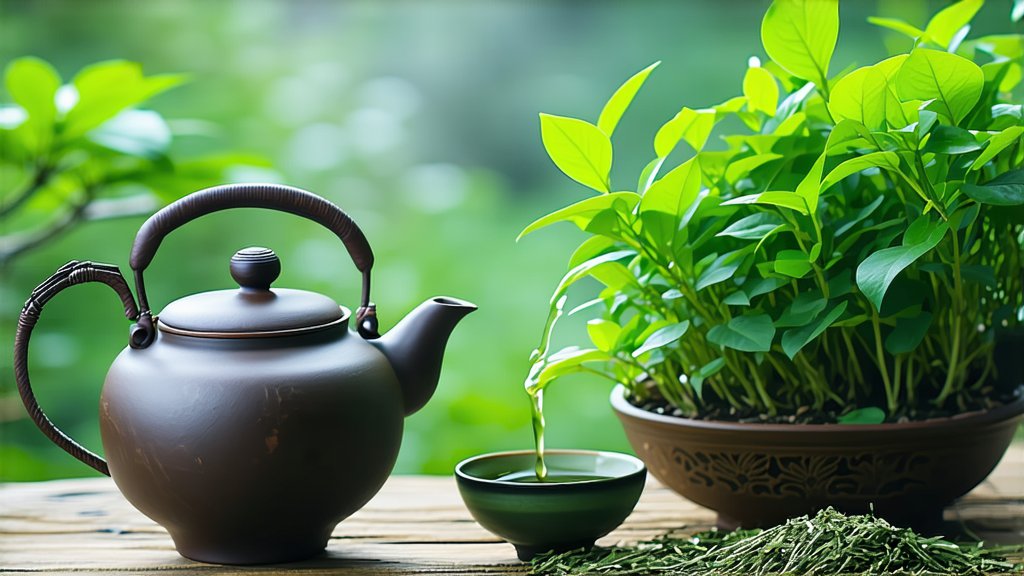
In the vast and diverse landscape of Chinese tea culture, few varieties capture the imagination and palate quite like Tieguanyin, a revered oolong tea that hails from the picturesque hills of Anxi County in Fujian Province. This exquisite tea, often referred to as the "Iron Goddess of Mercy," boasts a rich history intertwined with legend, a unique cultivation process, and a flavor profile that has captivated tea enthusiasts worldwide. Join us on a journey through time and tradition as we explore the depths of this remarkable beverage.
Historical Roots and Legendary Beginnings
The origins of Tieguanyin can be traced back to the early Qing Dynasty, around 1725 AD, during the reign of Emperor Yongzheng. According to local folklore, the tea was discovered by a poor scholar named Weiyin Wang who found refuge in a temple after failing his imperial exams. One night, he dreamt of a beautiful woman, later identified as Guanyin, the Goddess of Mercy, who guided him to a remote mountainside where he discovered a wild tea bush. He propagated these plants, and thus began the cultivation of what would become Tieguanyin.
Over centuries, Tieguanyin evolved from a local specialty to a globally recognized symbol of Chinese tea artistry. Its name, translating to "Iron Buddha," reflects both its strong character and the Buddhist roots embedded in its discovery story. Today, it stands as a testament to China's rich tea heritage and its ability to adapt and innovate while preserving age-old traditions.
Varieties and Cultivation
Tieguanyin primarily grows in the Wuyi Mountains of Anxi County, benefiting from the region's unique climate, high altitude, and fertile soil. There are two main types of Tieguanyin: traditional (Chuan Tong) and modern (Xin Zhuang). Traditional Tieguanyin undergoes a more extensive oxidation process, resulting in a darker leaf color and a fuller body with roasted notes. Conversely, modern Tieguanyin is lightly oxidized, yielding a lighter green hue and a fresher, floral aroma.
The cultivation of Tieguanyin tea plants requires meticulous care. Pruning is done annually to maintain the bushes at a manageable height, facilitating easier harvesting. Harvesting itself is an art form, typically carried out in spring and autumn when the leaves are at their prime. Only the tenderest shoots and leaves are selected, ensuring the highest quality for processing.
The Art of Processing
The transformation of freshly picked leaves into the aromatic delight of Tieguanyin involves several intricate steps:
-
Withering: Freshly harvested leaves are spread out under the sun or in a well-ventilated room to wilt slightly, reducing moisture content and softening the cell walls for better oxidation.
-
Brutonization (Tossing and Turning): This step involves repeatedly tossing the leaves in large woks or bamboo baskets over high heat. This not only halts oxidation but also contributes to the formation of unique flavors through Maillard reactions.
-
Fixation: After partial drying, the leaves undergo a rolling process that further breaks down cell structures, enhancing the release of aromatic compounds.
-
Oxidation: Depending on the desired variety, the leaves are allowed to oxidize to varying degrees before final drying.
-
Roasting: Finally, the leaves are roasted to remove any remaining moisture and develop the characteristic toasty notes associated with Tieguanyin.
Each stage demands precision and expertise, reflecting the deep respect for nature and tradition inherent in Chinese tea culture.
The Ritual of Gongfu Brewing
To truly appreciate Tieguanyin, one must engage in the ancient practice of Gongfu brewing, a ceremonial method that emphasizes control over water temperature, steeping time, and tea-to-water ratio. Here’s a brief guide to experiencing Tieguanyin at its best:
-
Preparation: Use a Yixing clay teapot or a Gaiwan (a lidded bowl), as they enhance the tea's aroma and flavor. Rinse the vessel with hot water to warm it up.
-
Water Temperature: Heat water to around 90-95°C (194-203°F). Boiling water can scorch the delicate leaves.
-
Tea Quantity: For a 150ml pot, use approximately 7-8 grams of tea leaves.
-
Steeping Time: The first infusion is a quick rinse, discarded immediately to awaken the leaves. Subsequent infusions should start with 15 seconds and gradually increase by a few seconds with each brew. Tieguanyin can be steeped multiple times, each revealing different layers of flavor.
-
Appreciation: Observe the liquor's color, inhale its fragrance, and savor the complexity of its taste—from floral and fruity notes to deeper roasted undertones. Each sip should be a meditative experience, connecting you to centuries of tea lore.
Conclusion
Tieguanyin is more than just a beverage; it embodies the philosophy of harmony between humanity and nature, a pursuit of perfection through simplicity, and a celebration of life's fleeting moments. As you delve into the world of this extraordinary oolong tea, remember that every cup tells a story—of mountains kissed by mist, hands skilled by generations, and a culture deeply rooted in the wisdom of the past. Embrace the ritual, savor the flavors, and let Tieguanyin transport you to a realm where time stands still, and every sip is a journey into the soul of China.